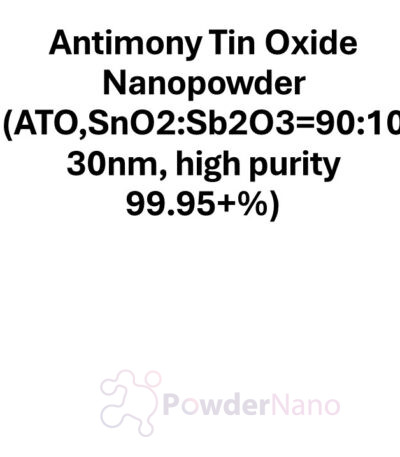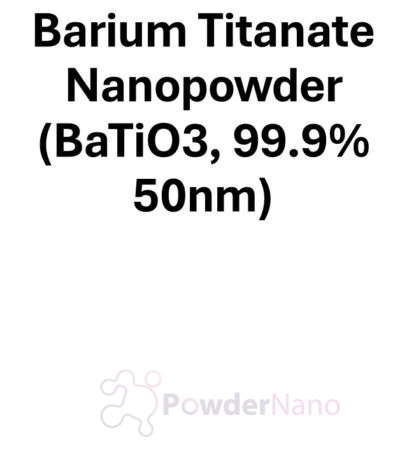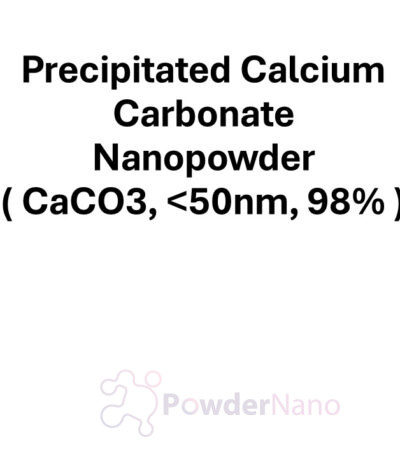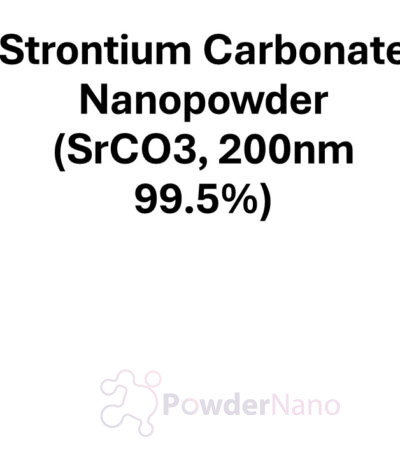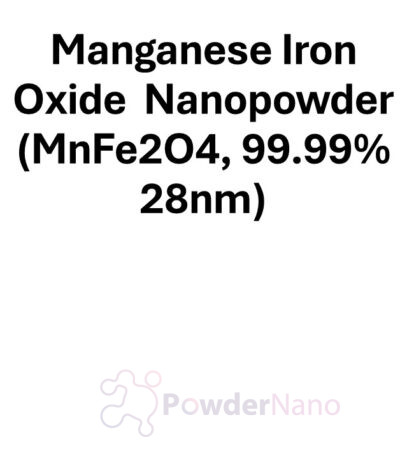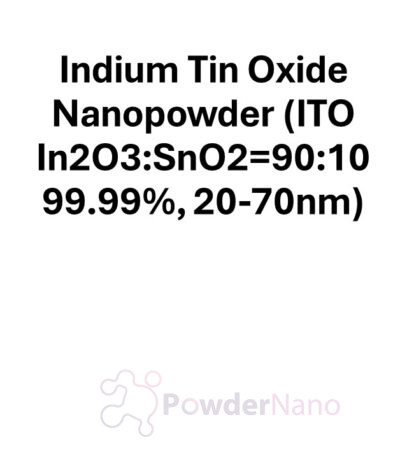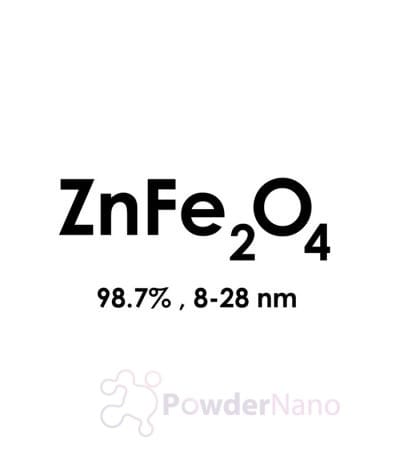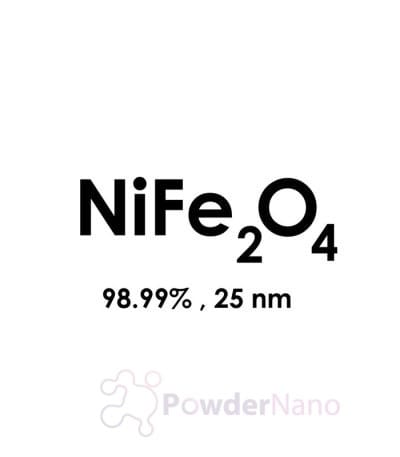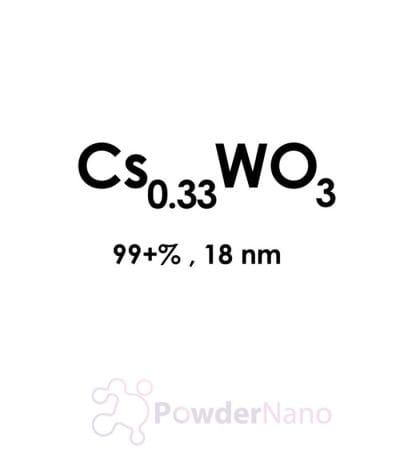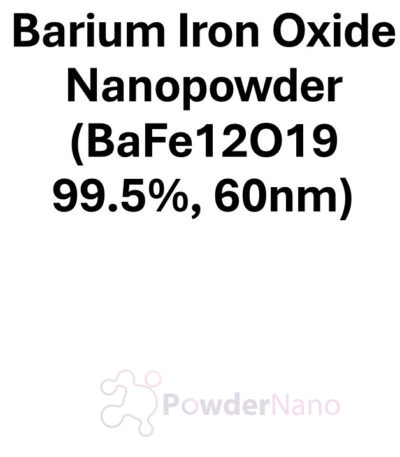Technical Specifications
1. General Information
- Product Name: Barium Iron Oxide Nanopowder
- Chemical Formula: BaFe₁₂O₁₉ (Barium Hexaferrite)
- Purity: ≥ 99.5%
- Particle Size: 60 nm
- Form: Fine nanopowder
- Color: Black to dark brown
2. Chemical Composition
- Elemental Composition:
- Barium (Ba)
- Iron (Fe)
- Oxygen (O)
- BaFe₁₂O₁₉ is a complex compound consisting of Barium and Iron Oxides
- Impurities: Trace amounts of other oxides, typically from manufacturing processes
- Moisture Content: ≤ 1%
3. Physical Properties
- Particle Size Distribution: 60 nm with a controlled size distribution
- Surface Area: 20-50 m²/g (varies based on processing)
- Density:
- Bulk Density: 5.0 g/cm³
- Tap Density: 4.5 g/cm³
- Melting Point: ~1,300°C
- Boiling Point: Decomposes before boiling
- Thermal Stability: Stable up to 1,100°C without significant structural degradation
- Crystalline Structure: Hexagonal (M-type hexaferrite) structure
4. Morphological Characteristics
- Shape: Primarily spherical or elongated nanoparticles
- Agglomeration: Moderate tendency to agglomerate; may require dispersants or surface treatments for uniform distribution in applications
- Surface Morphology: Smooth to slightly rough surfaces, with functional groups depending on processing and functionalization
5. Handling and Storage
- Storage Conditions: Store in a cool, dry place, away from moisture and contaminants to maintain product purity
- Packaging: Typically available in sealed, moisture-resistant containers to prevent contamination and moisture absorption
- Safety Precautions:
- Avoid inhalation of fine dust particles; use appropriate respiratory protection
- Wear protective gloves, safety goggles, and protective clothing during handling
- Handle in a well-ventilated area or under an inert atmosphere if necessary
- Avoid exposure to open flames or high temperatures, as barium iron oxide can react under extreme conditions
6. Regulatory Compliance
- Standards: Complies with relevant material safety standards such as REACH (Registration, Evaluation, Authorization, and Restriction of Chemicals) and RoHS (Restriction of Hazardous Substances)
- Certifications: May vary based on manufacturer; ensure compliance with local and international regulations as applicable
7. Synthesis Methods
- Solid-State Synthesis: This involves mixing metal oxides (barium oxide and iron oxide) and sintering them at high temperatures to form barium hexaferrite. The particle size can be controlled by adjusting synthesis conditions.
- Sol-Gel Processes: Uses a liquid-phase process to form barium ferrite nanoparticles. This method enables better control over size and uniformity.
- Hydrothermal Synthesis: Conducts reactions in aqueous solutions at high temperatures and pressures to produce high-purity BaFe₁₂O₁₉ nanoparticles with controlled crystallinity and morphology.
- Microwave-Assisted Synthesis: Uses microwave energy to accelerate the chemical reaction, resulting in the formation of nanoparticles with high uniformity and reduced processing times.
8. Functionalization
- Surface Treatments: Can be functionalized with various chemical groups (e.g., hydroxyl, carboxyl) to enhance compatibility with different matrices or to impart specific properties such as hydrophobicity, magnetism, or catalysis.
- Dispersants: May require the addition of dispersing agents or surfactants to prevent agglomeration in composite materials and ensure uniform distribution.
Applications
1. Magnetic Materials
- Permanent Magnets: Barium hexaferrite (BaFe₁₂O₁₉) is a well-known permanent magnet material used in the production of high-energy magnets, offering strong magnetic properties.
- Magnetic Storage Devices: Employed in the production of magnetic storage media such as hard disks and magnetic tapes, where high coercivity is required.
- Magnetic Separation: BaFe₁₂O₁₉ nanoparticles are used in magnetic separation processes for the removal of impurities, particularly in water treatment and the mining industry.
2. Electronics and Sensors
- Magnetic Sensors: Barium hexaferrite is used in sensors for measuring magnetic fields or detecting the presence of specific magnetic materials. This makes it valuable in applications like proximity sensors and magnetic field detectors.
- High-Frequency Devices: Due to its high magnetic permeability and low loss, BaFe₁₂O₁₉ is used in high-frequency applications, such as inductors, transformers, and microwave devices.
- Magnetic Recording: Used in the manufacture of recording heads for data storage devices, improving the efficiency and stability of the data storage process.
3. Microwave and RF Applications
- Microwave Absorbers: Due to its magnetic properties, BaFe₁₂O₁₉ nanoparticles are used in microwave absorbers for reducing electromagnetic interference (EMI) in electronic devices, particularly in mobile phones, radar, and military applications.
- High-Frequency Filters: Employed in high-frequency filters and components, such as those used in communication systems and radar systems, where stable and efficient magnetic properties are essential.
4. Catalysis and Chemical Industry
- Catalyst for Chemical Reactions: BaFe₁₂O₁₉ is used as a catalyst or catalyst support in various chemical reactions, including oxidation and hydrogenation reactions, where it can help enhance reaction rates and selectivity.
- Environmental Catalysis: Used in catalytic converters and other environmental catalytic applications, particularly for the breakdown of harmful pollutants in automotive and industrial exhaust gases.
5. Magnetic Nanocomposites
- Reinforcement in Polymers and Ceramics: BaFe₁₂O₁₉ nanoparticles are incorporated into composite materials to improve their magnetic properties and to create lightweight, high-strength materials. This is particularly valuable in automotive, aerospace, and electronics industries.
- Magnetic Nanocomposites for Biomedical Applications: Used in the development of nanocomposites for medical applications, such as drug delivery systems and targeted therapy, taking advantage of their strong magnetic properties for controlling the release of drugs.
6. Energy and Power Generation
- Energy Harvesting Systems: BaFe₁₂O₁₉ is used in energy harvesting systems, particularly in devices designed to convert mechanical energy into electrical energy through magnetization and electromagnetic induction.
- Energy Storage: Incorporated into devices used for energy storage, such as batteries and supercapacitors, to improve their performance, stability, and charge-discharge efficiency.
7. Biomedical Applications
- Magnetic Resonance Imaging (MRI) Contrast Agents: BaFe₁₂O₁₉ nanoparticles are used as contrast agents in MRI, improving the clarity and detail of imaging, particularly in the detection of tumors and other abnormalities.
- Magnetic Drug Delivery: Due to their magnetic properties, BaFe₁₂O₁₉ nanoparticles are being explored for use in drug delivery systems, allowing for the targeted delivery of drugs to specific areas of the body by applying an external magnetic field.
8. Automotive and Aerospace
- Magnetic Actuators and Motors: BaFe₁₂O₁₉ is used in the production of magnetic actuators, which are crucial for controlling systems in automotive and aerospace industries, especially in electric vehicles and aircraft.
- High-Temperature Magnets: Employed in components that must operate in high-temperature environments, such as electric motors, sensors, and actuators used in industrial and aerospace applications.
9. Environmental Remediation
- Water Treatment: Used in advanced water treatment processes, particularly in the removal of heavy metals and other contaminants through magnetic separation.
- Soil Remediation: BaFe₁₂O₁₉ is used for soil cleanup processes, where it helps in extracting contaminants such as oil and heavy metals through its magnetic properties.
10. Additive Manufacturing
- 3D Printing of Magnetic Materials: BaFe₁₂O₁₉ nanoparticles are used in the 3D printing of magnetic materials, particularly for creating complex, high-performance magnetic structures in applications that require precision and custom designs.
